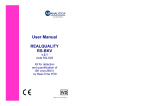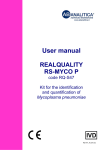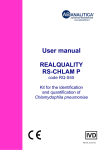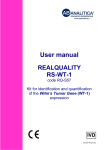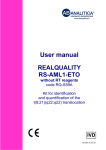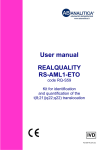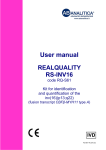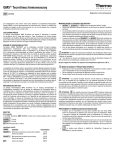Download User manual
Transcript
User manual REALQUALITY RS-BKV code RQ-S49 Kit for identification and quantification of the BK Virus RQ-S49-48_EN.doc 1 1.1 PRODUCT INFORMATION 3 Intended use 3 2 KIT CONTENT 4 3 STORAGE AND STABILITY OF THE REAGENTS 5 4 PRECAUTIONS FOR USE 5 5 SAFETY RULES 6 5.1 General safety rules 6 5.2 Safety rules about the kit 7 6 MATERIALS REQUIRED, BUT NOT PROVIDED 8 6.1 Reagents 8 6.2 Instruments 8 6.3 Materials 8 7 INTRODUCTION 9 8 TEST PRINCIPLE 11 9 PRODUCT DESCRIPTION 13 10 COLLECTION, MANIPULATION AND PRE-TREATMENT OF THE SAMPLES 14 10.1 Blood and plasma 14 10.2 Urine 14 11 PROTOCOL 15 11.1 DNA extraction 15 11.2 Internal control 15 11.3 Instrument programming 11.3.1 Creation of thermal protocol 11.3.2 Plate setup 16 16 16 11.4 QUALITATIVE ANALYSIS PROTOCOL 17 11.5 QUANTITATIVE ANALYSIS PROTOCOL 18 1 RQ-S49-48_EN.doc 11.6 ANALYSIS AND INTERPRETATION OF THE QUALITATIVE RESULTS 19 11.7 ANALYSIS AND INTERPRETATION OF THE QUANTATIVE RESULTS 21 12 TROUBLESHOOTING 23 13 DEVICE LIMITATIONS 24 14 DEVICE PERFORMANCES 24 14.1 Analytical specificity 24 14.2 Analytical sensitivity: detection limit 24 14.3 Analytical sensitivity: linearity 25 14.4 Reproducability 25 14.5 Diagnostic specificity 26 14.6 Diagnostic sensitivity 26 14.7 Accuracy 26 15 REFERENCES 27 16 RELATED PRODUCTS 28 RQ-S49-48_EN.doc 2 1 PRODUCT INFORMATION 1.1 Intended use The REALQUALITY RS-BKV is an IVD for identification of BK Virus (BKV) DNA by amplification of the gene coding the Large T antigen. If used together with the REALQUALITY RQ-BKV STANDARD code RQ-50ST kit, it allows the quantification of the number of the viral DNA molecules present in the sample. This kit uses Real-Time PCR amplification, starting from DNA extracted from human clinical samples. This in vitro diagnostic test is an auxiliary device for diagnosis and monitoring of BKV infections. It is recommended to use this kit as indicated in the instructions herein. This manual refers to the following product: REALQUALITY RS-BKV Kit for identification and quantification of the BK virus (BKV) by Real time PCR. This product is in accordance with 98/79/CE regarding the in vitro medical diagnostic devices (CE mark). Contains all the reagents needed for Real time amplification. Code Product RQ-S49-48 REALQUALITY RS-BKV RQ-S49-96 REALQUALITY RS-BKV 3 PKG 48 test 96 test RQ-S49-48_EN.doc 2 KIT CONTENT BOX F* STORE AT -30°/– 20°C DESCRIPTION TUBE (T) OR LID COLOUR LABEL 2X Mastermix 2X EV Real time Mix Primer and probe Mix for BKV amplification and β-globin gene Oligomix BKV Purple 24 test 48 test 96 test 1 x 340 L 2 X 340 L 4 X 340 L 1 x 27 L 2 x 27 L 4 x 27 L BOX F STORE AT +2°/ +8°C LABEL TUBE (T) OR LID COLOUR 24 test 48 test 96 test DNA containing a part of the BKV genome BKV POSITIVE CONTROL Purple 1 x 30 L 1 x 60 L 1 x 110 L DNA containing a part of the β-globin gene BG POSITIVE CONTROL Blue 1 x 30 L 1 x 60 L 1 x 110 L DNA containing a part of the β-globin gene INTERNAL CONTROL 2 x 125 L 4 x 125 L 8 x 125 L DESCRIPTION RQ-S49-48_EN.doc 4 3 STORAGE AND STABILITY OF THE REAGENTS Each component of the kit must be stored according to the directions indicated on the label of each box. In particular: Box F* Box F Store at -30°C/-20°C Store at +2°C/+8°C If stored at the recommended temperature, all test reagents are stable until their expiration date. The 2X EV Real Time Mix and Oligomix are sensitive to physical state variations. The reagents should not undergo more than two freeze/thaw cycles. If each batch has a small number of samples, it is recommended to aliquot the reagents. 2X EV Real time Mix and Oligomix contain fluorescent molecules, so they should be stored away from direct light. 4 PRECAUTIONS FOR USE The kit must be used only as an IVD and handled by qualified technicians, who are educated and trained in molecular biology techniques applied to diagnostics; Before starting the kit procedure, read carefully and completely the user manual; Keep the kit away from heating sources and direct light; One must pay particular attention to the expiration date on the label of each box: do not use any part of the kit past the expiration date; The reagents present in the kit must be considered an undividable unit. Do not divide or use different reagents from other kits or lots; All the reagents must be thawed at room temperature before use; once thawed, mix the solutions by inverting the tubes several times (do not vortex!), then centrifuge them briefly; Prepare the reaction quickly at room temperature or work on ice or on a cooling block. 5 RQ-S49-48_EN.doc In case of any doubt about the storage conditions, box integrity or method application, please contact AB ANALITICA’s technical support at: [email protected]. During nucleic acid amplification, the technician has to take the following special precautions: Use filter-tips; Store the biological samples, the extracted DNA, positive control included in the kit and all the amplicons in a different area from where the amplification reagents are stored; Organize the work areas in different pre- and post-PCR units; do not share instruments and consumables (pipettes, tips, tubes, etc.) between them; Change gloves frequently; Wash the bench surfaces with 5% Sodium Hypochloride. 5 SAFETY RULES 5.1 General safety rules Wear disposable gloves to handle reagents and clinical samples and wash hands at the end of work; Do not pipette by mouth; Since no known diagnostic method can assure the absence of infective agents, it is a good rule to consider every clinical sample as potentially infectious and handle it as such; All the devices that come in contact with clinical samples must be considered as contaminated and disposed of as such. In case of accidental spilling of the samples, clean up with 10% Sodium Hypochlorite. The materials used to clean up should be disposed in special containers for contaminated products; RQ-S49-48_EN.doc 6 Clinical samples, materials and contaminated products must be disposed of after decontamination: immerse in a solution of 5% Sodium Hypochlorite (1 volume of 5% Sodium Hypochlorite solution for every 10 volumes of contaminated fluid) for 30 minutes; OR autoclave at 121°C for at least 2 hours (NOTE: do not autoclave solutions containing Sodium Hypochlorite!!). 5.2 Safety rules about the kit The risks for the use of this kit are related to the single components. Dangerous components: none. The Material Safety Data Sheet (MSDS) of the device is available upon request. 7 RQ-S49-48_EN.doc 6 MATERIALS REQUIRED, BUT NOT PROVIDED 6.1 Reagents DNA extraction reagents; Sterile DNase and RNase free water; REALQUALITY RQ-BKV STANDARD code RQ-50-ST (for quantitative analysis). 6.2 Instruments Laminar flow cabinet (its use is recommended while preparing the amplification mix to avoid contamination; it would be recommended to use another laminar flow cabinet to add the extracted DNA and standard solutions); Micropipettes (range: 0.5-10 µL; 2-20 µL; 10-100 µL; 20-200 µL; 1001000 µL); Microcentrifuge (max 12-14,000 rpm); Plate centrifuge (optional); Real time amplification instrument. The kit was standardized on Applied Biosystems 7500 Fast Dx, 7300, StepOnePlus Real-Time PCR System (Applied Biosystems); the kit can be utilized on instruments that use 25 μL of reaction volume and can detect the FAM and JOE fluorescence correctly. The latter fluorophore can be read in the channels Cy3, HEX, etc. For more information on instrument compatibility of the kit, please contact AB ANALITICA’s technical support. 6.3 Materials Talc-free disposable gloves; Disposable sterile filter-tips (range: 0.5-10 µL; 2-20 µL; 10-100 µL; 20200 µL; 100-1000 µL); 96-well plates for Real time PCR and optical adhesive film or 0.1-0.2 mL tubes with optical caps. RQ-S49-48_EN.doc 8 7 INTRODUCTION The Human Polyomavirus BK (BKV) belongs to the Polyomaviridae family, and was first isolated in 1971 from the urine of a renal transplant patient with initials BK. The virus is widely spread among population with up to 90% of seroconversion in adults, in which the antibodies persist for life. The primary infection is developed during childhood, and generally it is asymptomatic, except in rare cases in which it causes acute respiratory infection or cystitis. The way of transmission is not well defined yet, but seems to include both aerial transmission (aerosol) and ingestion of materials contaminated by infected urine. After the first infection, BKV remains latent in the cells of urogenital tract and in other sites (ureter, brain, spleen, B lymphocytes) and sometimes it reactivates. The reactivation (often asymptomatic) has been reported in pregnant women (5-10%) and in immunodepressed patients. In these patients, the BKV infection is linked to different pathologies, among which hemorrhagic cystitis, interstitial nephritis, ureteral stenosis, disseminated vasculopathies, bladder cancer and multiple organ failure situations. The interstitial nephritis linked to BKV infection (BKVAN) was recently discovered as an important cause of renal dysfunction after kidney transplant; it happens in about 1-10% of kidney receivers. The most part of BKAVN cases happens within the first year after transplant and are due to the massive multiplication of the virus in the tubular epithelium. From the 90s, the more frequent use of strong immunosuppressors such as Tacrolimus (TAC) has brought about an increase of BKAVN that are now confused with the acute rejection of the organ or with tissue damage caused by pharmacological toxicity (Agha & Brennan, 2006). The acute rejection episodes lead to the increase of the immunosuppression, related to a larger incidence of BKAVN. If it is diagnosed, it can reduce to a minimum the risk of severe renal dysfunction and oxygen loss reported in 10-80% of kidney transplants (Hirsch et al., 2005). Moreover, a correct BKAVN diagnosis is important for therapeutic treatment because, opposite to acute rejection, it is based on the reduction of immunosuppressor medicines (Vats et al., 2003). In the receivers of allogeneic transplant of bone marrow the main problem caused by BKV is the hemorrhagic cystitis that starts late(HC) that is present in the 20-30% of cases. The viruria proceeds, comes with cystitis and it could extend after the resolution. It has been reported that the viral load in the urine and blood of patients is significantly higher than in the asymptomatic reactivation episodes of the same infection (Pavlakis et al., 2006). Currently the less invasive and more sensible diagnostic technique is the Polymerase Chain Reaction (PCR) that detects the viral genome presence. 9 RQ-S49-48_EN.doc Indeed the BKV isolation on tissue cultures is not so feasible, due to the slow replication cycle, and the serologic investigation is not so important because of the high diffusion of the virus among human population. Today, there are no antiviral therapies that aim to fight the infection caused by this virus, a precocious diagnosis of the infection and a careful follow up of the viral load in the blood are essential. The confirmation of high viral loads in the blood of kidney and bone marrow transplant patients could lead to the use of all the measures needed for preventing the development of pathologies linked to BK virus and for preventing the damage of the transplanted organ (decrease/modulation of immunosuppressive therapy). Kidney transplant programs have established BKV screening and quantitative tests are requested more often. In 2005, a group of experts have recommended BKV screening, either with urine cytology or nucleic acid research, of renal transplanted in the first 2 years after transplant (Hirsch et al., 2005). These guidelines include even a quantitative indication of cutoff concerning the BKV viral load that justifies the request of further investigations: a viral load > 107 copies/mL in the urine or > 104 copies/mL in plasma that persist more than 3 weeks is a diagnosis of “assumed BKVAN” and it should be followed by a renal biopsy. The Real time PCR, besides detecting the virus in a short amount of time, allows in the same time to monitor the viral load resulting in one of the most suitable technique for the management of Polyomavirus infections. RQ-S49-48_EN.doc 10 8 TEST PRINCIPLE The PCR method (Polymerase Chain Reaction) was the first method of DNA amplification method described in literature (Saiki RK et al., 1985). It is can be defined as an in vitro amplification reaction of a specific part of DNA (target sequence) by a thermostable DNA polymerase. This technique was shown to be a valuable and versatile instrument of molecular biology: its application contributed to a more efficient study of new genes and their expression and has revolutionized the fields of laboratory diagnostics and forensic medicine. The Real-time PCR represents an advancement of a basic research technology, providing the possibility to determine the number of amplified DNA molecules (amplicons) during the polymerase chain reactions. The monitoring of amplicons is based on primers or probes labeled with fluorescent molecules (molecular beacon, scorpion primer, etc.). These primers or probes usually contain a fluorophore (reporter) and a molecule that blocks the reporter’s specific fluorescence (quencher). Fluorescent emission is determined by the relative proximity of the reporter molecule to the quencher. While a primer or probe are not bound to a target sequence their reporter and quencher are in close proximity and the reporter’s fluorescence is blocked. Upon binding to a target sequence the quencher and reporter become separated and the light emitted by the reporter can be detected. Typically, the main part of a Real-time PCR run consists of several (30 – 50) amplification cycles. The higher the initial concentration of an amplified sequence the earlier the PCR produces an amplicon concentration that displays a fluorescence clearly distinguishable from the background. Thus, the initial concentration of a target sequence can be determined. Specific for each reaction is the so-called Ct value or threshold cycle. It is defined as the point or cycle at which the fluorescence signal becomes clearly distinguishable from the background while the PCR is still in the exponential amplification phase. The latter condition makes sure the number of amplicons is proportional to the number of reaction cycles passed. Using a standard curve the initial concentration of a target sequence can be calculated. The standard curve is established by amplifying standard samples with known concentrations of the target sequence. A thermocycler equipped with a corresponding detector can record the fluorescence events and thus monitor the reaction in “real time”. 11 RQ-S49-48_EN.doc The initial concentration of the target in the samples is determined by comparing the Ct value of each sample with a standard curve that was created by amplifying standards with known concentrations (Figure 1). Figure 1: Creating a standard curve using standards with known concentrations. The main advantage of Real-time PCR compared to conventional techniques of amplification is the possibility to perform a semi-automated amplification. This means the extra steps necessary to visualize the amplification result can be avoided and the risk of contamination by postPCR manipulation is reduced. RQ-S49-48_EN.doc 12 9 PRODUCT DESCRIPTION The REALQUALITY RS-BKV kit code RQ-S49 is an IVD for identification of BK virus (BKV) by amplification of the gene coding for the Large T antigen. If used together with REALQUALITY RQ-BKV STANDARD code RQ-50-ST, , it allows the quantification of the number of bacterial genome copies present in the sample. The respective standard curve consists of 4 points (from 102 to 105 genome copies per reaction). The positive controls supplied in this kit contain DNA fragments that correspond to the genetic region of interest, and as such, these controls are not dangerous for the user. The kit allows to detect the presence of reaction inhibitors and to monitor the extraction process by amplification of the β-globin gene (amplification control) in multiplex with the target pathogen. This is a valuable tool for identifying false-negative results. In cellular samples the endogenous gene is amplified. For acellular specimens an internal control is added which consists of recombinant DNA containing the β-globin gene. The kit includes a ready-to-use Mastermix and an Oligomix. The Oligomix contains the specific primers and probes, whereas the Mastermix contains all reagents necessary for the amplification reaction as well as the following components: ROX™ is an inert colorant that exhibits stable fluorescent properties throughout all amplification cycles. On some Real-time PCR instruments it is used for normalization in order to compensate for differences between wells caused by pipetting errors or instrument limitations. The dUTP/UNG system prevents contamination from previous amplification runs. The dUTPs are used to incorporate uracil residues into amplicons during amplification sessions. Before each new run the UNG enzyme degrades any single or double stranded DNA containing uracil. This way any amplification products from former sessions are eliminated. 13 RQ-S49-48_EN.doc 10 COLLECTION, MANIPULATION AND PRETREATMENT OF THE SAMPLES For the identification of a BK Virus infection, the clinical materials usually used in laboratories are plasma and urine; tests are rarely done with whole blood. The device was tested on extracted DNA from plasma, urine and whole blood. 10.1 Blood and plasma Sample collection should follow all the usual sterility precautions, as routine. Blood must be treated with EDTA, because other anticoagulation agents, as Heparin, are strong inhibitors of TAQ polymerase and so they could alter the efficiency of the amplification reaction. Plasma can be separated from whole blood by centrifuging at a slow speed with or without using a special tube containing gel-barriers. Both fresh whole blood and plasma can be stored at +2/+8°C if processed in a short time; if DNA extraction is not performed in a short time, the sample must be frozen. 10.2 Urine Urine must be collected in a sterile container, store at +2°C/+8°C for a maximum of 24 hours, before being processed. RQ-S49-48_EN.doc 14 11 PROTOCOL 11.1 DNA extraction For DNA extraction, it is recommended the QIAamp DNA Mini Kit or for whole blood, the QIAamp DNA Blood Mini Kit (QIAGEN, Hilden, Germany). For use, follow the user manual for of the manufacturer. The IVD can be used with DNA extracted from the most common manual and automated extraction methods. For further information regarding the compatibility of the device with different extraction methods, please contact AB ANALITICA’s technical support. 11.2 Internal control The kit includes an internal control consisting of a recombinant DNA containing part of the β-globin gene (BG). The use of this control is recommended for the analysis of acellular samples and allows one to verify both the extraction procedure and any possible inhibition of the amplification reaction. The standardization experiments of the internal control were done using 10 µL of internal control with a final elution volume equal to 60 µL. When the extraction system in use has a different final elution volume, adjust proportionally the volume of the internal control to be used. In order to use the internal control correctly, follow the instructions provided by the extraction system manufacturer. In acellular samples in which one uses the internal control, as described above, the expected Ct will be ≤ 35 (Applied Biosystems 7500 Fast Dx Real time PCR System; Threshold 0.05). For any further information, please contact AB ANALITICA’s technical support. 15 RQ-S49-48_EN.doc 11.3 11.3.1 Instrument programming Creation of thermal protocol Set the following thermal profile: Cycle Repeats Step Time (°C) 1 2 1 1 1 1 2:00 10:00 50.0 95.0 3 45 1 00:15 95.0 2* 01:00 60.0 UNG Activation Taq Activation Amplification cycles * Fluorescence collection step 11.3.2 Plate setup Mark the grid of the new plate with the position of the negative control (NTC), standards (STD) and samples (Unknown), making sure the position is the same as on the plate and identify each sample with its name. For the quantitative protocol, define the dilution of the BKV standard in the interval from 102 to 105 viral genome copies/reaction. Set the BKV and BG detector as follows: Name BKV β-globin Reporter Dye FAM JOE Quencher Dye none none Pay attention that, for the instruments that require it, the detection of the fluorescence of the fluorophore ROX™ corresponds to each position. ROX™ is an inert colorant in which the fluorescence does not undergo changes during the amplification reaction; on instruments that use ROX (Applied Biosystems, Stratagene, etc.), it is used to normalize eventual differences between wells caused by artifacts from pipetting errors or instrument limitations. Record, where required, that the final reaction volume is 25 μL. RQ-S49-48_EN.doc 16 11.4 QUALITATIVE ANALYSIS PROTOCOL Once thawed, mix the reagents by inverting the tubes several times (do not vortex!), then centrifuge briefly. Prepare the reaction mix rapidly at room temperature or work on ice or on a cooling block. Try, when possible, to work in an area away from direct light. Prepare, as described below, a mix sufficient for all the samples to be tested, counting also the positive and negative control, in the latter H2O is added instead of DNA, and when calculating the volume, consider an excess of at least one reaction volume. Reagent 2X EV Real time Mix Oligomix BKV H2O Total Volume 1 Rx 12.5 μL 1 μL 6.5 μL 20 μL Mix by inverting the tubes several times, in which the mix was prepared in and then centrifuge briefly. Pipette 20 μL of the mix in each well on the plate. Add 5 μL of extracted DNA to each well or 5 μL of positive control DNA, in the correct position on the plate. Always amplify a negative control together with the samples to be analyzed (add sterile water instead of extracted DNA to the corresponding well). Hermetically seal the plate by using an optical adhesive film or the appropriate sealer. Make sure that there are no air bubbles in the bottom of the wells and/or centrifuge the plate at 4000 rpm for about 1 minute. Load the plate on the instrument making sure to position it correctly and start the amplification cycle. 17 RQ-S49-48_EN.doc 11.5 QUANTITATIVE ANALYSIS PROTOCOL The quantitative analysis can be performed by using REALQUALITY RQBKV STANDARD code RQ-50-ST. Follow the instructions reported in the previous paragraph to prepare a reaction mix sufficient for the standard curve. A negative amplification control must be included on the plate, in which H2O is added instead of DNA. Aliquot 20 μL of the mix in each well on the plate. Add 5 μL of extracted DNA to each well or 5 μL of each quantification standard dilution, in the corresponding positions on the plate. Hermetically seal the plate by using an optical adhesive film or the appropriate sealer. Make sure that there are no air bubbles in the bottom of the wells and/or centrifuge the plate at 4000 rpm for about 1 minute. Load the plate on the instrument making sure to position it correctly and start the amplification cycle. RQ-S49-48_EN.doc 18 11.6 ANALYSIS AND INTERPRETATION OF THE QUALITATIVE RESULTS At the end of the reaction, view the graph in logarithmic scale. Analyze the BKV and β-globin amplification results separately by selecting the correct detector and use the following instructions for interpretation. Before considering the sample results, make sure that the positive and negative controls have the expected results. β-globin positive control β-globin negative control BKV positive control BKV negative control RESULT INTERPRETATION Amplification signal present Correct β-globin amplification No amplification signal Amplification problems, repeat the analysis No amplification signal No contamination Amplification signal Contamination, repeat the analysis RESULT Amplification signal present INTERPRETATION Correct BKV amplification No amplification signal Amplification problems, repeat the analysis No amplification signal No contamination Amplification signal Contamination, repeat the analysis 19 RQ-S49-48_EN.doc β-globin detector Amplification signal No amplification signal BKV detector INTERPRETATION Amplification signal Sample positive for BKV No amplification signal Sample negative for BKV Amplification signal Sample positive for BKV* No amplification signal Sample not suitable Repeat the DNA extraction *ATTENTION: The assay was standardized in order to favour the target pathogen amplification reaction. Therefore, the amplification signal of the βglobin gene (fluorescence in JOE) can have a delayed or absent Ct in BKV positive samples. RQ-S49-48_EN.doc 20 11.7 ANALYSIS AND INTERPRETATION OF THE QUANTATIVE RESULTS At the end of the reaction, view the graph in logarithmic scale (Figure 2). Position the Threshold by choosing the position in which the Correlation Coefficient (R2) and the slope of the curve values are the closest possible to 1 and -3.33, respectively (Figure 3). Results are considered acceptable, when the efficiency of the amplification is between 90 – 110% (slope approximately -3.60 - -3.10) and the Correlation Coefficient value is not less than 0.99. Figure 2: Post run data analysis: amplification graph displayed in logarithmic scale. 21 RQ-S49-48_EN.doc Figure 3: Post run data analysis, standard curve. RQ-S49-48_EN.doc 22 12 TROUBLESHOOTING Absence for amplification signal positive controls/standard solutions and samples The instrument was not programmed correctly – Repeat the amplification and program the instrument carefully; pay particular attention to the thermal profile, the selected fluorophores and the correspondence between the plate protocol and the plate itself. The amplification mix was not prepared correctly – Prepare a new amplification mix making sure to follow the instructions given in paragraph 11.3. The kit was not stored properly or it was used past the expiration date – Check both the storage conditions and the expiration date reported on the label; use a new kit if needed. Weak amplification signal intensity of positive controls/standard solutions Positive controls/standards were stored in correctly and have degraded – Store the positive controls/standard solutions correctly at +2°C/+8°C, and make sure that they do not undergo any freeze/thaw cycle as well; – Do not use the positive controls/standard solutions past the expiration date. The reaction mix does not function correctly – Make sure to store the 2X EV Real time Mix and Oligomix correctly at -20°C/-30°C. Avoid unnecessary freeze/thaw cycles. Amplification signal of β-globin very delayed or absent in the extracted sample (BKV negative) The extracted DNA is not suitable for amplification and the amplification reaction was inhibited – Make sure to extract the nucleic acids correctly; – If an extraction method uses wash steps with solutions containing Ethanol, make sure no Ethanol residue remains in the DNA sample; – Use the extraction methods suggested in paragraph 11.1. For any further problems, please contact AB ANALITICA’s technical support at: [email protected], fax (+39) 049-8709510, or tel. (+39) 049761698). 23 RQ-S49-48_EN.doc 13 DEVICE LIMITATIONS The kit can have reduced performances if: The clinical sample is not suitable for this analysis (sampling and/or storage error, i.e. blood treated with anticoagulants other than EDTA, like heparin, etc.); DNA is not suitable for amplification (due to the presence of amplification reaction inhibitors or to the use of inappropriate extraction method); The kit was not stored correctly. 14 DEVICE PERFORMANCES 14.1 Analytical specificity The specificity of the REALQUALITY RS-BKV code RQ-S49 is guaranteed by an accurate and specific selection of primers and probes, and also by the use of stringent amplification conditions. The alignment of primers and probes in the most important databanks shows the absence of non-specific pairing. In order to determine cross-reactivity of this device, samples positive to other potentially cross-reactive viruses were amplified with this device. None of the tested pathogens were reactive. 14.2 Analytical sensitivity: detection limit Serial dilutions of quantification standard, ranging from 1 to 0.05 copies of viral genome copies/μL, were tested in three consecutive experiments in order to determine the analytical sensitivity. For each dilution, 5 μL were amplified in eight replicates per run, in multiplex with the internal control. The results were analyzed by Probit analysis, as illustrated in the graph reported in Figure 4. The limit of the analytical sensitivity for the REALQUALITY RS-BKV (p = 0.05) kit is reported in Table 1. RQ-S49-48_EN.doc 24 Figure 4: Graph of the Probit analysis results for determination of analytical sensitivity for the REALQUALITY RS-BKV kit on Applied Biosystems 7500 Fast DX Real-Time PCR System expressed in genome viral copies/reaction. 14.3 Analytical sensitivity: linearity The linearity of the assay was determined using a quantification standard panel. The results of the analysis are reported in Table 1, with the linear regression. 14.4 Reproducability A 50 copies/uL dilution (corresponding to a final amount of 250 copies/reaction) of the quantification standard was amplified in eight replicates in the same run, in order to determine the intra-assay variability (variability among the replicates of a certain sample in the same assay). The intra-assay variability coefficient of the method, in respect to the Cycle threshold (Ct), is reported in Table 1. The last point of the quantification standard (20 viral genome copies/uL) was amplified in duplicates in three consecutive runs in order to determine the inter-assay variability (variability of the replicates of the same sample in different runs). For each run, the variability coefficient was calculated from the Ct of the samples. 25 RQ-S49-48_EN.doc The inter-assay variability coefficient was calculated from the average of the variable coefficients in each experiment performed and is reported in Table 1. ABI 7500 Fast Dx ABI 7300 StepOne Plus 0.3 0.4 0.4 2.5 – 107 2.5 – 107 2.5 – 107 Intra-assay variability 0.237% 0.401% 0.496% Inter-assay variability 0.107% 0.717% 0.457%, Table 1 Detection Limit (viral genome copies/µL) Probit p = 0.05 Linearity Range (viral genome copies/reaction) 14.5 Diagnostic specificity A significant number of BKV negative samples were tested simultaneously with the REALQUALITY RS-BKV kit and another CE IVD or reference method. From the obtained results, the diagnostic specificity of this device was calculated to be 100%. 14.6 Diagnostic sensitivity A significant number of BKV positive samples were tested simultaneously with the REALQUALITY RS-BKV kit and another CE IVD or reference method. From the obtained results, the diagnostic specificity of this device was calculated to be 100%. 14.7 Accuracy This value was calculated as the number of correct amplifications over the total number of executed amplifications. The REALQUALITY RS-BKV device has an accuracy of 100%. RQ-S49-48_EN.doc 26 15 REFERENCES Agha I, Brennan DC Adv Exp Med Biol 577, 174-184, 2006. Hirsch HH et al. Transplantation 79,1277-86, 2005. Pavlakis et al. Advances in Experimental Medicine and Biology 577, 185-189, DOI: 10.1007/0-387-32957-9_13, 2006. Saiki RK et al. Science 230, 1350-1354, 1985. Vats A et al. Transplantation 75(1),105-12, 2003. 27 RQ-S49-48_EN.doc 16 RELATED PRODUCTS REALQUALITY RQ-BKV STANDARD Ready-to-use quantification standard for BK virus (BKV) quantification. This product is in accordance with 98/79/CE Directive (Annex III) regarding the in vitro medical diagnostic devices (CE mark). Code RQ-50-ST RQ-S49-48_EN.doc Product REALQUALITY RQ-BKV STANDARD 28 PKG 4 x 60 µL AB ANALITICA srl Via Svizzera 16 - 35127 PADOVA, (ITALY) Tel +39 049 761698 - Fax +39 049 8709510 e-mail: [email protected]
































